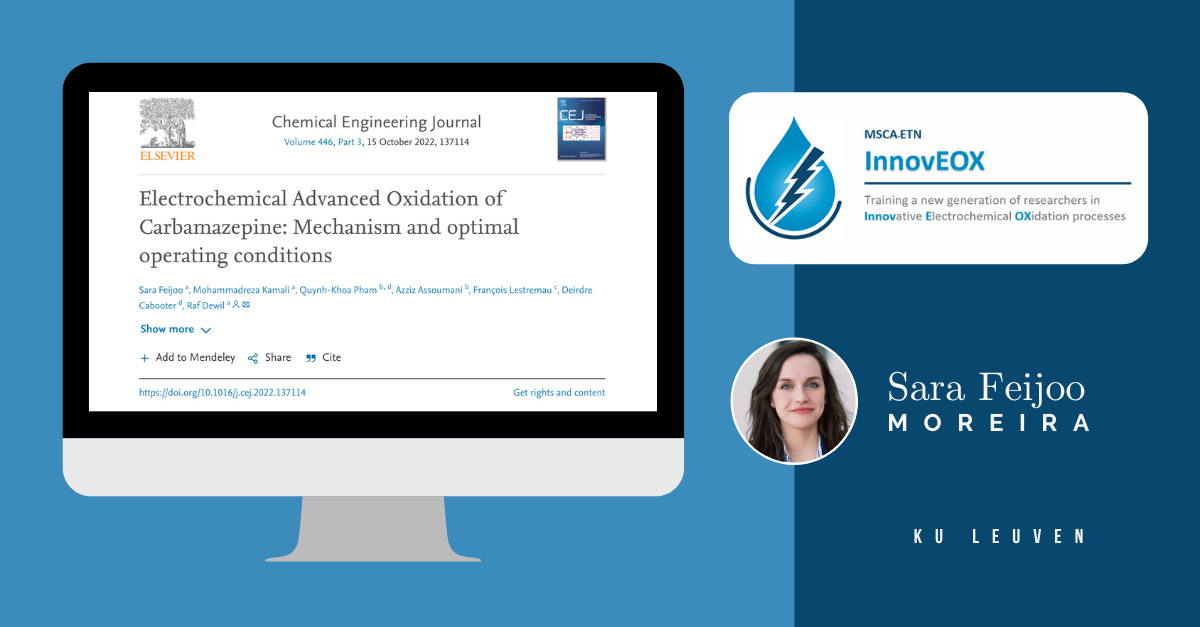
New paper by KU Leuven and INERIS researchers Sara Feijoo Moreira, Mohammadreza Kamali, Quynh-Khoa Pham, Azziz Assoumani, François Lestremau, Deirdre Cabooter and Raf Dewil on the electrochemical oxidation of carbamazepine.
Highlights
- • Electrochemical degradation of carbamazepine via boron-doped diamond anode was completed in 5 min.
- • Taguchi optimization showed that pH was the most influencing operating condition.
- • Optimal results were obtained at near-neutral pH in the presence of nitrate and sulfate ions.
- • The participation of different radical species was linked to the oxygen evolution reaction.
- • 10 intermediate transformation products were detected and fully removed after treatment.
Effective electrochemical degradation of carbamazepine (CBZ) in water was accomplished with minimal energy and chemical requirements, showing that electrochemical Advanced Oxidation Processes (eAOPs) with a Boron-Doped Diamond (BDD) anode are a promising method for the in situ degradation of contaminants of emerging concern (CECs). The influence of several operating parameters (i.e., pH, temperature and initial anolyte and pollutant concentrations) was determined through the Taguchi optimization method. Optimal conditions corresponded to 1 μM CBZ, pH 2, 30 °C, 10 mM Na2SO4 and 50 A m−2, resulting in complete CBZ removal in less than 5 min. Complementary scenarios with different ion species, energy sources and current densities further corroborated the suitability of the optimum. Moreover, they revealed that the optimal conditions were driven by the presence of both SO42− and NO3− ions in solution. Hence, the optimal degradation results were also attained when replacing HNO3 by NaNO3, which allowed to operate without prior pH adjustments. The contribution of •OH and SO4•− radicals was studied through scavenging tests and it was for the first time tentatively ascribed to the Oxygen Evolution Reaction (OER), since the selection of the operating potential influences the type of oxidative species present. Finally, the primary transformation products formed during CBZ degradation under optimal conditions were investigated.
Full reference paper
Sara Feijoo, Mohammadreza Kamali, Quynh-Khoa Pham, Azziz Assoumani, François Lestremau, Deirdre Cabooter, Raf Dewil, Electrochemical Advanced Oxidation of Carbamazepine: Mechanism and optimal operating conditions, Chemical Engineering Journal, 2022, DOI:10.1016/j.cej.2022.137114.
Acknowledgements
This project has received funding from the European Union’s EU Framework Programme for Research and Innovation Horizon 2020 under Grant Agreement No 861369.
 InnovEOX Innovative Electrochemical OXidation Processes for the Removal and Analysis of micro-pollutants in water streams
InnovEOX Innovative Electrochemical OXidation Processes for the Removal and Analysis of micro-pollutants in water streams



